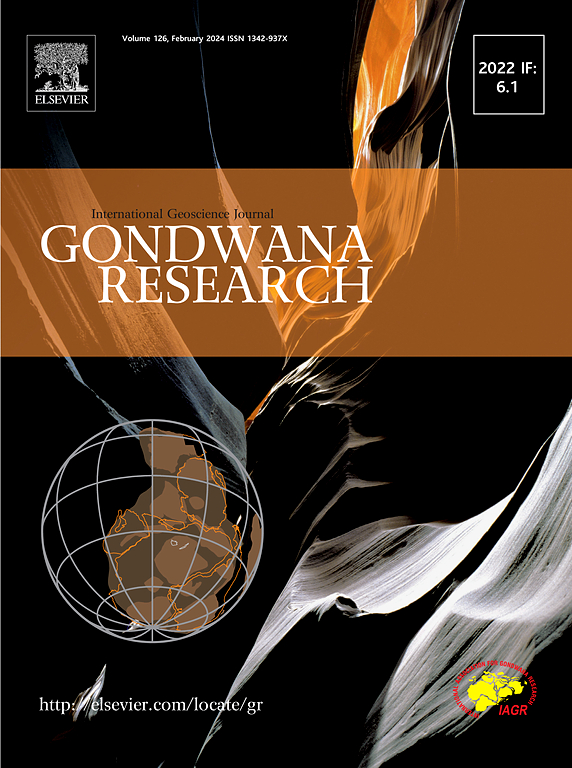中国海域及邻区岩石圈三维结构:结合大地水准面、重力和地形数据
IF 7.2
1区 地球科学
Q1 GEOSCIENCES, MULTIDISCIPLINARY
引用次数: 0
摘要
太平洋板块、欧亚板块、菲律宾海板块和卡洛琳板块的汇聚使中国海域及其邻近地区成为研究洋陆过渡时期岩石圈演化的天然实验室。通过整合多个地球物理数据集(大地面线、自由空气重力异常、地形和地震莫霍约束)的先进联合反演框架,我们提出了一个新的三维岩石圈模型。本研究有三个关键进展:(1)分区参数化方案获得了比常规模型更高的横向分辨率,圈定了15个具有不同热密度特征的构造单元(10 km网格);(2)整合地震莫霍约束、地壳/沉积密度、地幔热调制密度,实现岩石圈的综合表征;(3)重点岩石圈样带揭示:①克拉通盆地岩石圈逐渐减薄(鄂尔多斯:160±5 km);四川:155±7 km)至活动边缘(冲绳海槽:80±10 km), LAB隆升幅度(渤海湾:50±8 km;华南地块:35±6 km)与太平洋板块回滚相关;(ii)南海海底扩张导致LAB隆升40±5 km,与地幔上升流有关,与以往的地球动力学模拟一致。这些发现重新定义了研究区岩石圈的三维框架,说明了板块边界力、地幔动力学和岩石圈变形之间的相互作用。虽然我们的结果不会从根本上改变该地区岩石圈的整体图像,但我们的结果为推进地球动力学模型提供了更好的约束,并为复杂板块相互作用中的非均衡俯冲动力学提供了关键见解。本文章由计算机程序翻译,如有差异,请以英文原文为准。
The 3D lithospheric structure of China Seas and adjacent areas: Combining geoid, gravity, and topography data
The convergence of the Pacific, Eurasian, Philippine Sea, and Caroline Plates makes the China Seas and adjacent areas a natural laboratory for studying lithospheric evolution at ocean-continent transitions. We present a novel three-dimensional (3D) lithospheric model through an advanced joint inversion framework integrating multi-geophysical datasets (geoid, free air gravity anomaly, topography, and seismic Moho constraints). This study features three key advances: (1) A zonal parameterization scheme achieving higher lateral resolution than conventional models, delineating 15 tectonic units (10 km grid) with distinct thermal and density properties; (2) Integration of seismic Moho constraints, depth-dependent crustal/sedimentary densities, and thermally modulated mantle densities to enable comprehensive lithospheric characterization; (3) Key lithospheric transects reveal: (i) Progressive lithospheric thinning from cratonic basins (Ordos: 160 ± 5 km; Sichuan: 155 ± 7 km) to active margins (Okinawa Trough: 80 ± 10 km), with LAB uplift amplitudes (Bohai Bay: 50 ± 8 km; South China Block: 35 ± 6 km) correlating with Pacific slab rollback; (ii) Seafloor spreading in the South China Sea has resulted in LAB uplift of 40 ± 5 km, associated with mantle upwelling consistent with previous geodynamic modeling. These findings redefine the 3D lithospheric framework of the study area, illustrating the interplay between plate boundary forces, mantle dynamics, and lithospheric deformation across ocean-continent transitions. Although our results don’t change fundamentally the overall lithospheric image of the area, our results provide better constraints for advancing geodynamic models and offer key insights into non-isostatic subduction dynamics within complex plate interactions.
求助全文
通过发布文献求助,成功后即可免费获取论文全文。
去求助
来源期刊

Gondwana Research
地学-地球科学综合
CiteScore
12.90
自引率
6.60%
发文量
298
审稿时长
65 days
期刊介绍:
Gondwana Research (GR) is an International Journal aimed to promote high quality research publications on all topics related to solid Earth, particularly with reference to the origin and evolution of continents, continental assemblies and their resources. GR is an "all earth science" journal with no restrictions on geological time, terrane or theme and covers a wide spectrum of topics in geosciences such as geology, geomorphology, palaeontology, structure, petrology, geochemistry, stable isotopes, geochronology, economic geology, exploration geology, engineering geology, geophysics, and environmental geology among other themes, and provides an appropriate forum to integrate studies from different disciplines and different terrains. In addition to regular articles and thematic issues, the journal invites high profile state-of-the-art reviews on thrust area topics for its column, ''GR FOCUS''. Focus articles include short biographies and photographs of the authors. Short articles (within ten printed pages) for rapid publication reporting important discoveries or innovative models of global interest will be considered under the category ''GR LETTERS''.
 求助内容:
求助内容: 应助结果提醒方式:
应助结果提醒方式:


